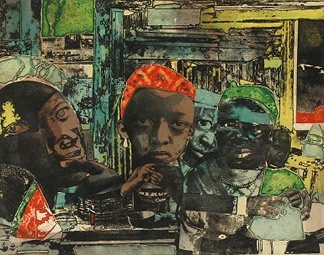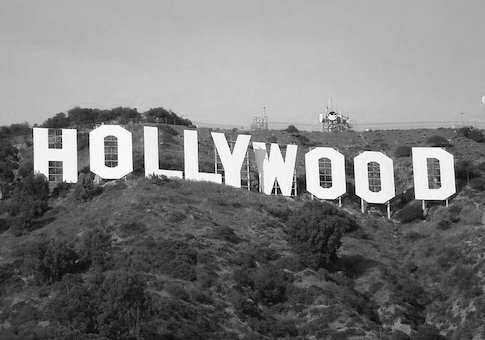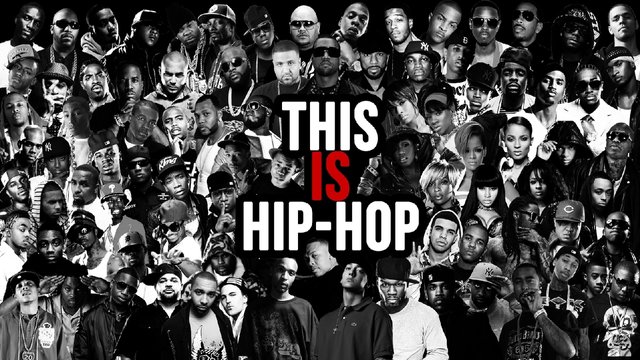Sampling is one of the most fundamental pillars of hip-hop music. Investigating the cultural gestures surrounding sampling, cutting, flipping, and producing reveals greater meaning from within the hip-hop community and beyond. Joseph Schloss, expert in the field, imagines hip-hop as collage; similar to black visual collage artists, such as Romare Bearden, hip-hop artists organize samples to form a new relationship in an act of spontaneity. This essay is a short investigation of how the sample’s origin integrates into its new host, specifically looking at the ways in which Hollywood film sound byte samples are utilized in hip-hop culture. I will explore the underlying social and cultural implications of using samples from a notoriously white industry in hip-hop music as well as the aesthetic reasons for the convergence of these media forms.

Before I delve into the complex relationship between Hollywood and hip-hop beats, it is important to acknowledge that just as hip-hop is an inherently African-derived form, Hollywood is inherently white. Hollywood whiteness as an identity, a social formation, a form of representation is, at its very core, synonymous with racism. While black stardom is nearly unattainable through film, Arthur Knight argues, “African-Americans never lacked stars.” As a result of systematic oppresion, black stardom is based off of a different set of values and implications; a star in African American culture is a “dense syncretic bundle of concepts, figurations, and processes.” Meanwhile, white stardom is systematically intertwined with the cultural standards of white America. Hollywood’s golden age spanning from silent films till films in the 1960’s was predicated by significant social and international events that affected racial formation in United States. WWII, segregation, global wars and domestic conflicts, and the resulting emergence of the contemporary civil rights movement were all being broadcasted on the silver screen. African Americans at this time made up about 15% of viewership, which made it economically unviable for filmmakers to shift out of the white lens. Yet movies greatly impacted, and continue to impact, the American tradition.

This again, does not mean that black stardom was obsolete. African-American stars emerged out of a complex narrative of oppression through song and dance in the Harlem renaissance and began to garner national attention that extended out from the African-American community. At this point in stardom, black artists have to grapple with the question of remaining “authentic” within his/her own circles or to ascend to the mainstream—a realm subjugated by whiteness; and if not, what are the ethical repercussions of white people appropriating black performance? This issue is still a quintessential concern to contemporary black artists. It could be argued that the problems associated with appropriation of hip-hop culture by white musicians are, at their essence, synonymous with the racist implications of 19th-20th century blackface.

The convergence of hip-hop and Hollywood is a story of Western and African tradition colliding and birthing a lovechild, who despite its historically complex roots, still manages above all else, to achieve one simple objective—sounding good. Schloss argues that if something does not sound good, no matter the producer’s symbolic goals, it will be rejected. Producer Samson S. confronts this phenomenon with the idea of “straight sound,” or a measure of the most important facet in hip-hop music—vibes.
That noted, I’d like to explore the reasons why producers find Hollywood sound bytes aesthetically pleasing; and beyond aesthetics, address the ways in which remediation from visual (film) to purely audio form recontextualizes the clips.
The idea behind “straight sound,” as an indicator of quality can be applied outside of the realm of hip-hop. The basis of “straight sound,” truly boils down to a beat that is aesthetically pleasing for one reason or another. In the same way, film—while it can have political and social implications—is at its core, a vessel of mass entertainment. It is something that feels good to watch. It is an industry profiting off of American nostalgia. Films have the ability to travel through time and space to hit that sweet melancholic pang that we experience as we travel with it. This migratory nature of film is also the foundation of sampling in hop-hop music. Steven Feld writes, “sound recordings, split from their source through the chain of audio production, circulation, and consumption, stimulate and license renegotiations of identity.” Sound is mobile and re-experiencing old media in contemporary contexts is aesthetically and emotionally pleasing. The phenomenon of remediating film clips in hip-hop music is the practice of taking an American tradition that is just slightly out of reach and recontextualizing it in a language that contemporary listeners can consume. In such, sampling is its own form of resurrection. This ‘zombie’ approach to sampling embodies the energy of a time dislocated from contemporary temporal reality.
Looping back in time is a strong facet of African-derived music. African music is traditionally rhythmic, percussive, and based on organization emphasizing breaks and loops. The looping and repetition spurs from traditional call and response songs. The cut back to a beginning of which we have already heard conveys a sense of continuity, security and creates circulation within the song to maintain equilibrium. Yet this refuge in repetition is also a rupture in the linear Western tradition. Barnor Hesse writes that this interruption “facilitates focus on a system of organizing experiences, space, which is the project of another temporality, not only a different history, but in effect the history of different spaces: the African diaspora.” In such, the construction of “future pasts” links lineages in diasporic time and space. While hip-hop is self-reflexive through cyclic form, Western movies--just as Western music--tells stories linearly. Western tradition is predicated on a predetermined template of conflict, climax, and resolution. However, though a singular story is told linearly, it is my belief that Western tradition eventually loops back on itself over time because a template is just that--reusable. The very notion of having a repeatable, if not mandatory structure to storytelling connotes repetition. In this way, the coalescence of micro-repetition in hip-hop music, and the recycled, recontextualized clips of movies creates somewhat of a juxtaposition that works, counter intuitively, harmoniously.
Finally, in attempting to piece apart what this unique relationship means in the context of hip-hop tracks, I will discuss GZA’s track, “Liquid Swords” off of the album by the same name as a case study.
The album heavily samples from the film Shogun Assassin (1980). The first track on the album opens up to a young boy telling the story of the his father and the “Shogun Assassin”:
When I was little, my father was famous
He was the greatest samurai in the empire
And he was the Shogun's decapitator
He cut off the heads of a hundred and thirty-one lords
It was a bad time for the empire
The Shogun just stayed inside his castle and he never came out
People said his brain was infected by devils
My father would come home, he would forget about the killings
He wasn't scared of the Shogun, but the Shogun was scared of him
Maybe that was the problem
Then, one night, the Shogun sent his ninja spies to our house
They were supposed to kill my father but they didn't
That was the night everything changed...
These lyrics already set up the story in Western tradition, the problem is presented, and the climax is presented. However, the resolution tails off and is absorbed into the lyrical portion of the song. The curiosity evoked by the cliffhanger and the little boy’s innocent voice achieves the sense of nostalgia. RZA (who is featured on the track) immediately begins by referencing past hip-hop tradition:
See, sometimes
You gotta flash em back
See n****s don't know where this shit started
Y'all know where it came from
I'm saying we gonna take y'all back to the source
Do the knowledge... yo!
The beat loops in the background, consistently starting again back over itself. The repetition in the beat is echoed in the backwards-looking implications of the lyrics. RZA dominates the space by calling out for the past—claiming authenticity by commandeering this trip “back to the source.” The trip back through hip-hop captures the eerie, atmospheric, imaginative cinematic aesthetic from Shogun Assassin in the space between the consistent hip-hop beats.
The relationship between beats and samples is complex and ever evolving. The elusive link between the Western and African tradition continues to expand and transmediation between film and music illuminates the culturally relevant and historically established web we’ve built around it.
Bibliography
Born, Georgina, and David Hesmondhalgh, eds. Western Music and Its Others: Difference, Representation,and Appropriation in Music. Berkeley: University of California Press, 2000.
Hesse, Barnor. “Place and The Politics of Identity.” In Black to Front and Black Again: Racialization through Contested Times and Spaces, 162–82. London: Routledge, 1993.
Knight, Arthur. “Star Dances: African-American Constructions of Stardom.” In Classic Hollywood Classic Whiteness, 386–414. University of Minnesota Press, 2001. http://www.jstor.org/stable/10.5749/j.ctttt7x9.21.
Rose, Tricia. Black Noise: Rap Music and Black Culture in Contemporary America. Music/culture. &Hanover, NH: University Press of New England, 1994.
https://drive.google.com/drive/folders/0B1-UQ8D3fnJwdmpBSk52QjNuSVk.
Schloss, Joseph. Making Beats: The Art of Sample-Based Hip-Hop. Middletown, US: Wesleyan University Press, 2014. ProQuest ebrary.
Warikoo, Natasha K., ed. “Music and Style: Americanization or Globalization?” In Balancing Acts, 1st ed., 23–45. Youth Culture in the Global City. University of California Press, 2011. http://www.jstor.org/stable/10.1525/j.ctt1pq0r5.6.
Zuberi, Nabeel. “Is This the Future? Black Music and Technology Discourse.” Science Fiction Studies 34, no. 2 (2007): 283–300.
this sample comes to mind. Intro track from the roots - things fall apart. It's taken from a spike lee film - mo betta blues. Follow up post - collection or spectrum exploration of samples. What kind come up more than others? I also think of aqua teen hunger force ... Mad villain I think
Downvoting a post can decrease pending rewards and make it less visible. Common reasons:
Submit
yes!!! this is such a cool track thanks for sharing. There's definitely so much more interesting sampling going on out there beyond film byte stuff (which actually isn't even that common). I wonder if there are any studies that break down the spectrum/types of samples...
Downvoting a post can decrease pending rewards and make it less visible. Common reasons:
Submit
Very cool! Has this been published previously?
Downvoting a post can decrease pending rewards and make it less visible. Common reasons:
Submit
I'll chime in because I happen to know. The answer is nope, it's a @glamdoll steemit original.
Downvoting a post can decrease pending rewards and make it less visible. Common reasons:
Submit
yes thank you! It is just on steem!
Downvoting a post can decrease pending rewards and make it less visible. Common reasons:
Submit
Nice!
Downvoting a post can decrease pending rewards and make it less visible. Common reasons:
Submit